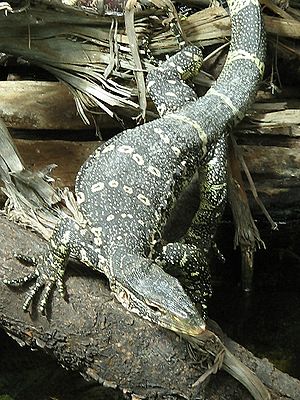Rainforest Nile Monitor
| Rainforest Nile Monitor | ||||||||||||
|---|---|---|---|---|---|---|---|---|---|---|---|---|

Rainforest Nile Monitor ( Varanus ornatus ) |
||||||||||||
| Systematics | ||||||||||||
|
||||||||||||
| Scientific name | ||||||||||||
| Varanus ornatus | ||||||||||||
| ( Daudin , 1803) |
The rainforest Nile monitor ( Varanus ornatus ) is a species of scale reptiles (Squamata) from the genus of monitor lizards ( Varanus ). Formerly classified as a subspecies of the Nile monitor ( Varanus niloticus ), the rainforest Nile monitor is now an independent species. It becomes about 2 m long, is similar to the Nile monitor strongly attached to the water and feeds mainly on crustaceans .
Systematics
It was first described in 1803 by François-Marie Daudin . For a long time recognized as an independent species, it was classified as a subspecies of the Nile monitor ( Varanus niloticus ) in Mertens' classic monograph on monitor lizards in 1942 . Zieger & Böhme (1997) raised the taxon , called Varanus niloticus ornatus , to the species status again, since the Nile monitor and its supposed subspecies occur sympatric without a transition from one to the other subspecies being recognizable. In addition, the morphology of the paryphasms on the hemipenes of the two species is different. Hence, the two taxa must be viewed as different, albeit very closely related, species.
features
The longest reliably measured specimen of the rainforest Nile monitor reached a total length of 1.9 m, but the skulls of two very large specimens suggest a length of more than 2.5 m. The tail is about 1.6-1.7 times as long as the head-torso length. The rainforest Nile monitor is very sturdy and has a large head.
The top of the body is blackish, with a light yellow pattern of line drawings on the head. On the back there are 5, rarely less, transverse bands of yellowish-black eye spots; this feature can be used to distinguish it from the otherwise very similar Nile monitor, as it usually has 6 or more of these bands. The dark base color with yellowish stippling is drawn between the bands. The tail shows 12 broad, yellow transverse bands. The underside of the body is yellow and covered with a wide-meshed black network drawing. The tongue is whitish to pink.
distribution and habitat
At the country level, it is distributed in Guinea , Sierra Leone , Liberia , Ghana , Nigeria , Cameroon , Equatorial Guinea , Gabon , the Central African Republic , the Democratic Republic of the Congo and Benin . In Nigeria it is called " Dgyou-Dgyou " and " Gedee " by the locals , in Benin " Guana " and in Nigeria and Tanzania " Ju-Ju ".
In large parts of its distribution area it lives sympatricly with the Nile monitor. The rainforest Nile monitor inhabits large parts of the central African tropical rainforests, especially the lowland rainforest, but also secondary forests , swamps, mangroves , savanna-like habitats on the edge of the forest, cleared areas and in the vicinity of human settlements. It usually lives near larger bodies of water and occurs at up to 1200 m above sea level.
Way of life
The rainforest Nile monitor is mainly ground-dwelling, but is also a good climber and a very good swimmer. It is diurnal and, in contrast to the Nile monitor, which also occurs in drier habitats, does not take a rest period in the dry season, but like its close relative is more active in the rainy season. He is actively looking for prey, especially crustaceans. According to studies by Angelici & Luiselli (1999), 56% of the rainforest Nile monitor feeds on crustaceans, vertebrates make up only 10% of their diet , 1.7% each of which are young crocodiles ( Osteolaemus tetraspis ) and younger conspecifics. While the young animals still have typical pointed teeth, a change to blunt molars takes place in the course of individual development, probably as an adaptation to the diet consisting mainly of crustaceans. The food spectrum of young animals is almost identical to that of adults despite the ontogenetic changes in the teeth.
Little is known about the reproduction of the rainforest Nile monitor in nature. In southeast Nigeria, pregnant females were found between late March and mid-April, the first pups in early May. In southeast Guinea and South Cameroon, however, newly hatched young animals were found in October. Parthenogenesis was observed in captive females ; the resulting clutches comprised 12 and 15 eggs. So far, parthenogenesis has not produced any viable young animals in the rainforest Nile monitor.
supporting documents
literature
- W. Böhme & T. Ziegler (2004): Varanus ornatus . In: ER Pianka & DR King (Eds.): Varanoid Lizards of the World , pp. 139-142. Indiana University Press, Bloomington & Indianapolis, ISBN 0-253-34366-6 .
Individual evidence
- ↑ K. Ullenbruch, O. Grell & W. Böhme (2010): Reptiles from southern Benin, West Africa, with the description of a new Hemidactylus (Gekkonidae), and a country-wide checklist . Bonn Zoological Bulletin 57 (1), pp. 31–54 ( full text ( memento of the original dated February 27, 2012 in the Internet Archive ) Info: The archive link has been inserted automatically and has not yet been checked. Please check the original and archive link according to the instructions and remove then this note .; PDF file; 1.43 MB).
- ↑ MK Bayless (2008): Local Names of Pan-African Monitor Lizards (Varanidae: Varanus: Polydaedalus) . Biawak 2 (2), pp. 61–71 ( full text ; PDF file; 339 kB).
- ↑ J. Hennessy (2010): Parthenogenesis in an Ornate Nile Monitor, Varanus ornatus . Biawak 4 (1), pp. 26–30 ( full text ; PDF file; 299 kB).
Web links
- Varanus ornatus in The Reptile Database
- Varanus olivaceus inthe IUCN 2013 Red List of Threatened Species . Posted by: Sy, E., Afuang, L., Duya, MR & Diesmos, M., 2009. Retrieved January 31, 2014.